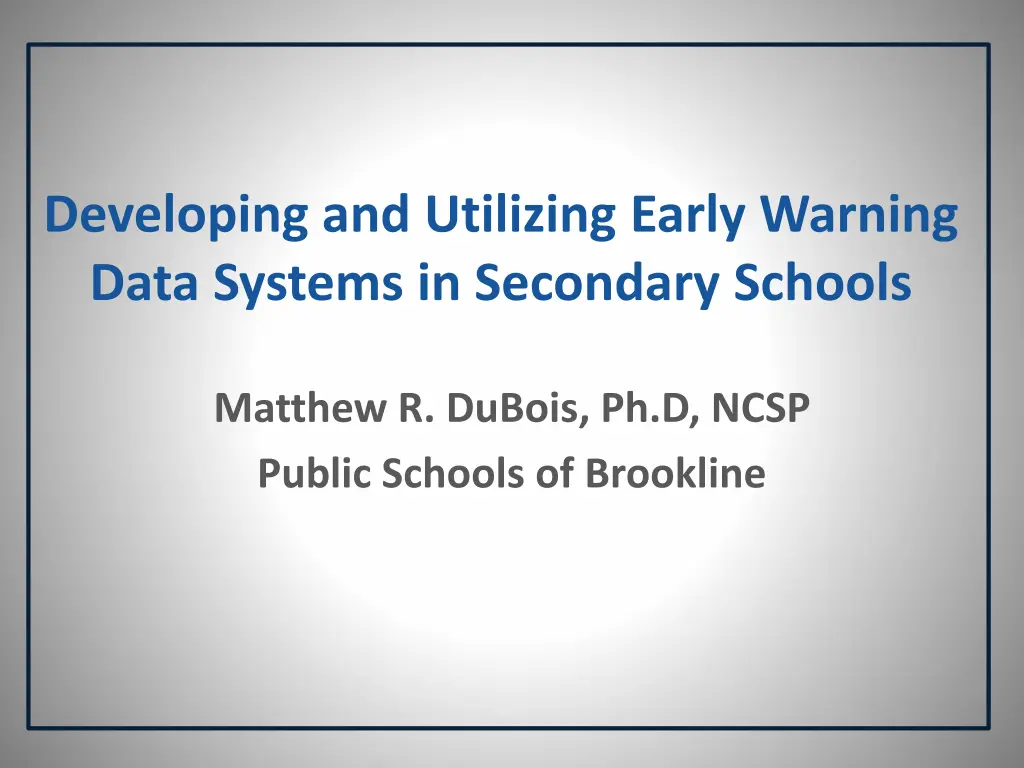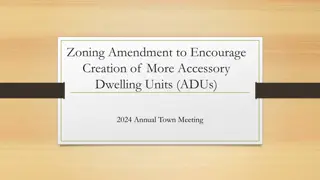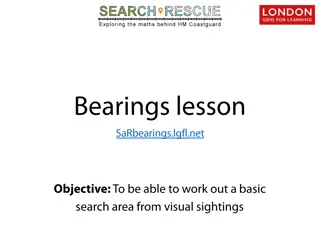
Developing and Utilizing Early Warning Data Systems in Secondary Schools by Matthew R. DuBois
Learn about the goals of developing an early warning data system in secondary schools to identify predictive factors for poor academic performance, create a supportive tool for at-risk students, and evaluate intervention effectiveness. Steps include analyzing predictors, using the EWIS platform, exploring additional risk factors, conducting student surveys, and forming an Early Warning Data Team.
Download Presentation

Please find below an Image/Link to download the presentation.
The content on the website is provided AS IS for your information and personal use only. It may not be sold, licensed, or shared on other websites without obtaining consent from the author. If you encounter any issues during the download, it is possible that the publisher has removed the file from their server.
You are allowed to download the files provided on this website for personal or commercial use, subject to the condition that they are used lawfully. All files are the property of their respective owners.
The content on the website is provided AS IS for your information and personal use only. It may not be sold, licensed, or shared on other websites without obtaining consent from the author.
E N D
Presentation Transcript
Developing and Utilizing Early Warning Data Systems in Secondary Schools Matthew R. DuBois, Ph.D, NCSP Public Schools of Brookline
Goals Identify the attendance and class performance thresholds that predict poor performance in core academic classes during 9thgrade. Create a tool that allows students to be identified, and subsequently provided support, as soon as the begin presenting with risk factors. Ensure that students most at need receive our most intensive supports. Evaluate the effectiveness of our interventions, supports, and school-based practices (student and school level).
Step 1: Identifying Predictors and Creating Thresholds Analyzed two 9th-grade cohorts (N = 1,024). Focused on attendance, grades, demographics Outcome variable: performance in core academic areas (Math, Science, History, English) Dichotomized as earning a D+ or lower or a C- or higher.
Other Variables School Connectedness/Mental Health Academic Self-Efficacy Behavior/Discipline Middle school performance (grades, attendance, MCAS)
Step 2: Creating the EWIS Platform Currently utilizing Google Sheets Updated every week (mostly manual entry) Focus on usability
Step 3: Exploring Additional Risk Factors Surveying students directly at multiple times throughout the year. School connectedness/belonging Mental health Academic self-efficacy
Student Survey Utilized Google Forms Survey students at 5 time points First week of school End of 1stquarter End of 2ndquarter End of 3rdquarter End of school year
Step 4: Making the Data Actionable Creation of an Early Warning Data Team (EWDT) Psychologist Director of Special Education Director of Guidance and Social Work Two general education teachers (including head of Advisory) A special education teacher BCBA Associate Dean Guidance Counselor 9thgrade social worker
EWDT School Year 2018-2019 Weekly hour-long meetings to: Review EWIS Data Email teams when students cross threshold (and begin problem solving process) Plan for presenting data to key stakeholders Prepare student surveys Develop additional supports
EWDT Threshold emails are sent when: Student has 4thabsence in a class in a quarter (and again after 6thabsence) Student earns 2ndgrade of D+ or lower on a report (and again after 3rdoccasion). Email is sent to student s entire team Approximately a 50% response rate from teachers. Helpful for problem definition and understanding.
EWDT After better understanding the problem, teachers and staff are directed to attempt other classroom-based, teacher-driven interventions. More significant and complex challenges result in a referral to our Child Study Team.
EWDT To share our work and begin shaping a culture around data we: Created a summary of BHS EWIS paper for faculty Hosted Data Walkthroughs and presented at department meetings. Presented EWIS data to Dean s Team each month
Step 5: Using Data to Drive Intervention Lunch Lounge 10% of 9thgraders reported to not having a close friend in 8thgrade. Eating lunch in cafeteria was frequently described when students were asked, What are you worried about in 9th grade. Safe place/Safe Person Guidance counselors, Deans, and/or Social Workers met with every 9thgrader who reported that they did not have a safe person in 8thgrade (40 students) and/or after 1st quarter (130 students).
Data Driven Intervention Guidance counselors or a social worker met with all students who endorsed symptoms of depression (and did not already have access to on-going treatment; 32 students). Family provided contact information for community mental health center after initial screen. Focus on Building Relationships 20 minutes in faculty meeting, followed up by a teacher training series (March and April)
Next Steps and Future Directions Currently analyzing 8th-grade data to identify variables that help predict 9thgrade performance. Improving transition process. Early stages in planning to extend work into elementary schools Improvements in Data Entry Embedding EWDT work into Dean s Teams





















